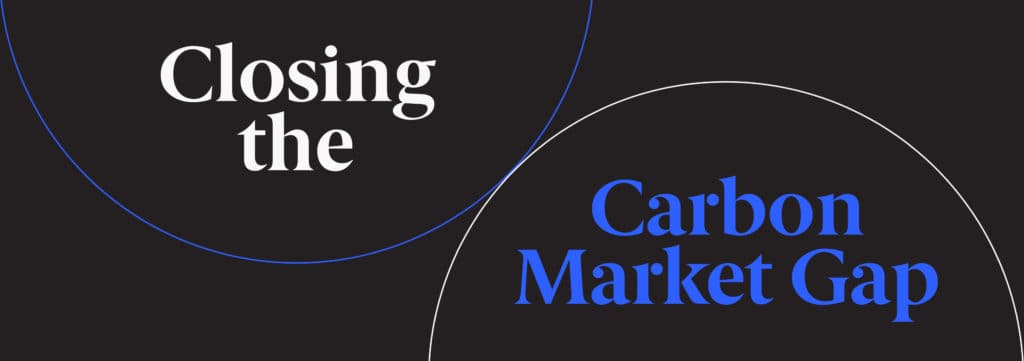Why Is It So Hard to Buy Carbon Credits?


WHAT IS THE CARBON MARKET?
We joined Joe Batir of the Energy Transition Solutions podcast to take a deep dive into how companies can leverage carbon offsets to meet their sustainability goals. Read the summary or listen now.
Navigating the carbon market can be unnecessarily complex and opaque without the right support.
Carbon credits allow companies to offset their carbon emissions for voluntary initiatives like achieving net-zero goals or to fulfill regulatory compliance obligations. When the number of offset credits retired, in combination with other decarbonization activities, equals the amount of carbon emissions released, the company is considered carbon neutral. However, navigating the carbon market can be unnecessarily complex due to a lack of transparency, fragmented marketplaces, and varying credit quality. As more companies pursue decarbonization and carbon neutrality, many are finding it increasingly difficult to find and buy high-quality carbon credits. Why is that the case? This article takes a closer look.
Why Is It So Hard To Buy Carbon Credits?
There are two primary complicating factors that make it hard to buy carbon credits. First, the carbon market lacks a unified marketplace where buyers and sellers transact, requiring buyers to interact with numerous sources to get pricing and information. Second, not all carbon credits are credit equal, which makes purchasing decisions more difficult.
Because there’s no main unified marketplace, many carbon credits are traded over the counter (OTC), which means that price and quality discovery requires relationships with various market participants—including project developers, brokers, and marketers—which increases complexity and effort for buyers. The ability to take ownership of carbon offsets and then retire them (the retirement step cancels out emissions), requires a registered user account on the associated carbon registry, which many buyers don’t have. Note: market participants like CarbonBetter can and do retire credits on behalf of buyers to make it easier for buyers to transact.
The second complicating factor is that not all carbon credit offset projects and not all issued credits are of the same quality. When evaluating which carbon credits to purchase, buyers need to consider the technology of the project, the registry and protocol used to develop the credits, vintage, geography, co-benefits, additionality, and more. All of these factors impact the quality and price of any given carbon credit. Carbon credit verification protocols are designed to ensure that each carbon offset credit represents one metric ton of carbon emissions avoided, reduced, or sequestered, but as protocols have changed over the years, some previously issued credits may no longer have the same environmental value as previously thought.
Buyers can navigate these challenges by working with a company like CarbonBetter to source, purchase, and retire carbon credits, or by conducting a request for proposal (RFP) to solicit offers for carbon offset credits from a range of sellers to get a snapshot view of the market at any given point in time to make a responsible credit purchase, but this process is cumbersome, complicated, typically outside of the buyer’s normal operations, and only needed on a periodic basis. Let’s break down the RFP process to make the carbon market and buying process more transparent.
Skip the RFP—CarbonBetter Can Help
CarbonBetter Certified Offset Portfolios allow carbon buyers to participate in a variety of projects, geographies, and technologies in one simple transaction rather than navigating a lengthy and complex RFP process with multiple carbon market participants.
Learn More About CBCO 22-1The Carbon Credit RFP Process Can Be Complex and Opaque
The RFP process enables carbon credit buyers to identify carbon offset projects and compare their performance, environmental factors, and per-credit costs. RFPs typically contain details about the quantity of credits needed, budget, preferred project technology, vintage range, and other relevant details about the purchase.
A successful RFP is sent to many sellers to ensure adequate carbon credit options are available for evaluation. These sellers may include project developers, brokers, marketers, or other entities that have an inventory of carbon credits available for sale. These entities are intermediaries who are involved in the RFP process, and they may charge a commission fee in addition to the carbon credit price. For buyers that are not routine carbon market participants, managing this process can be labor-intensive and confusing.
“Transacting with a carbon credit seller directly often requires master agreements, know your client forms, and eventually purchasing agreements once the trade is confirmed. When you use a company like CarbonBetter, these elements are all handled by us.”
HOW CARBONBETTER MAKES BUYING CARBON SIMPLER

Closing the Carbon Market Gap
According to Bank of America, carbon offset supply may need to grow as much as 50x by 2050 to achieve net-zero emissions. Watch the replay as three experts discuss efforts to close this gap and the challenges in developing projects and issuing credits at scale.

Carbon offset registries Overview
Carbon offsets are a tool for businesses and individuals that have made a commitment to reach net-zero emissions or are working to reduce their emissions. Learn more about the state of the carbon market, how credits are issued, and other considerations.
When dealing with counterparties directly—without the support of a company like CarbonBetter—there is an inherent risk because both the buyer and seller must meet the commercial obligations of the contract. Unless the purchase price for the offsets is prepaid, the buyer typically has to post credit to mitigate receivables risk, but the exact terms depend on the delivery and payment terms of the contract.
If you are working with a carbon credit broker, be aware that you will likely be required to contract with the broker and then contract again with the eventual seller they find who owns the carbon credits you intend to buy. CarbonBetter simplifies this for buyers by taking title of the carbon credit on the buyer’s behalf, which means there is only one transaction with CarbonBetter for the buyer.
The number of credits needed by the buyer affects the RFP process because if the quantity needed isn’t sizable enough, the available options and/or competitiveness of the pricing may be impacted. Some sellers will have minimum volume requirements associated with their offers.
Ultimately, any carbon credit offers received will need to be evaluated by comparing all of the offers. This requires an understanding of all of the underlying attributes of carbon credits, like vintage, technology, additionality, and leakage. Along with these dimensions, buyers must also compare payment terms and delivery timing of each offer before making a selection.
The RFP process for carbon credits is complex and time-consuming, but CarbonBetter helps companies source the right credits to meet specific requirements in a simple timeline and one transaction. CarbonBetter handles the entire RFP process, counterparty considerations, clearing risk, evaluation, and retirement of credits purchased.
There Is a Lack of Transparency in the Carbon Market
Registries, brokers, marketers, and marketplaces are the various entities in the carbon markets, and their roles are important:
- REGISTRIES CERTIFY AND ISSUE CREDITS: Carbon offset registries establish protocols for approving carbon projects and issuing carbon credits. Project developers work with registries to certify and issue credits for sale. There are a few major ones, including Verified Carbon Standard, American Carbon Registry, Climate Action Reserve, Gold Standard, and UNFCCC Kyoto Protocol’s Clean Development Mechanism (CDM), with varying scopes of geographies and technologies. There has also been an increase in the formation of niche registries that seek to address specific gaps not covered by the main registries, but they may not have the same level of rigor or transparency.





- OTHER MARKET PARTICIPANTS TRANSACT: Brokers, marketers, and marketplaces are the main entities facilitating carbon transactions.
Buyers need to know what they are searching for when shopping for carbon credits because, in the absence of preferences around technology and vintage, a buyer may choose credits based on price alone and may ultimately sacrifice quality. If buyers aren’t sure what they need in a carbon credit, they should work with companies that can hand-pick carbon offset projects for them based on their needs, offset amounts, and costs.
When buying from brokers and project developers, businesses often have limited project options, depending on their budget and quantity needs. Brokers and project developers typically want to sell carbon credits in high volume to make more money and to have a better chance of selling out their project, which can create challenges for smaller organizations working to achieve decarbonization goals. In addition, project developers typically do not engage with buyers directly because they have selected a marketing firm, like CarbonBetter, to minimize their transaction burden.
Some carbon credit marketplaces aim to make it easier for businesses to find what they need, including price transparency and the option to buy a limited amount of carbon credits. Marketplaces, such as the CBL platform, focus on liquidity, clearing risk, and price discovery to make the process easier for businesses that don’t have a company like CarbonBetter facilitating transactions. However, the carbon offset credit supply and the variety of credits are still limited. For example, CBL does not always provide specific project details until after you’ve transacted, therefore buyers may lack visibility into what they are buying. Marketplaces also require a contract, and sometimes an up-front fee, to get set up on the platform, as well as linked registry accounts to take title of the credits.
Increased Carbon Demand and Limited Credit Supply Add Complications
There is a larger demand for carbon credits than there is a supply of carbon offset projects, so companies looking to buy carbon offset credits may find it difficult to find the right projects without help. To date, 698 of the 2,000 largest publicly-traded companies in the world have made net-zero goals to be reached on or before 2050, and investing in carbon offset projects through the purchase of carbon credits is an effective way to reach these commitments, in tandem with company-specific decarbonization projects. According to McKinsey, demand for carbon credits could increase by a factor of 15 or more by 2030 and up to a factor of 100 by 2050. By 2030, the overall market for carbon credits could be worth upward of $50 billion.
The global inventory of carbon offset projects will likely not meet the increasing demand—between January and December 2021, the inventory of available carbon offset credits fell by about 50% due to increased demand and inelastic supply. Carbon offset projects take a lot of time to develop, and then they need to be verified and validated to achieve certification before carbon credits are issued. The supply of carbon credits is inelastic, so carbon credit buyers have to compete with one another for the limited quantities available, which means that the prices will likely continue to increase even as more projects are developed. Further, the increase in demand will likely continue growing due to anticipation that further regulations are forthcoming, which would expand compliance programs, carbon taxes, and more.
Firms planning to offset on a recurring basis in the future may consider using a forward contract to lock in their supply. Committing to an “off-take” of carbon credits from a project allows a business to retire carbon credits over a period of time (for example, “x” carbon credits per year over 5 years). This contract allows businesses to fix, or lock in, the cost of the carbon offset credits in anticipation of future price increases.
With the increasing price of carbon offsets, some companies may be priced out of purchasing them due to their budget constraints. High demand for carbon offset credits and low supply drives up prices. Carbon credits are not cheap to produce—it takes time and money to develop carbon offset projects, the carbon credits have to be validated and verified by a third-party company, and then they are finally placed into the carbon market for purchase and retirement. Demand for credits from nature-based solutions is particularly high, especially for projects that reduce emissions by protecting forests, grasslands, and particular ecosystems.
The Best Way to Buy Carbon Credits
Buying carbon credits doesn’t have to be hard, but without the right help it can be complicated and burdensome for companies to navigate the carbon credit RFP process and associated complications related to specific credit requirements. With CarbonBetter’s Certified Offset Portfolios (CBCO), you can get instant access to a variety of hand-picked, certified carbon offset projects to meet your needs, budget, and preferences. CarbonBetter also supports buyers with specific needs, preferences, and requirements, including long-term off-take agreements. Contact us today for carbon sourcing support.
One of the main difficulties involved in buying carbon credits is determining the legitimacy and quality of the credits being purchased. There are a variety of different certification standards and programs, and it can be challenging for buyers to navigate and understand them. Additionally, there is no global regulatory framework for carbon markets, which can lead to concerns about fraud or greenwashing. Buyers must also consider the additionality and permanence of the carbon credits they purchase, as well as any potential social or environmental impacts associated with the offset projects.
To ensure that the carbon credits you purchase are legitimate and high-quality, it is important to do your research and work with reputable vendors. Look for certifications from respected third-party organizations, such as the Verified Carbon Standard or Gold Standard, which have rigorous standards for project additionality, environmental integrity, and social and environmental co-benefits. Additionally, be wary of credits that are being sold at unusually low prices, as this may be a sign of poor quality or fraudulent credits. Finally, make sure to carefully review the documentation and verification reports associated with the credits before making a purchase.
Yes, there are several other challenges to consider when buying carbon credits. One of these is the issue of double counting, which can occur when multiple parties claim the same carbon offset. This can undermine the environmental benefits of carbon offsets and create confusion in the marketplace. Buyers should also be aware of potential issues related to geographic and sectoral diversification, as well as the availability and accessibility of credits for different types of emissions sources. Finally, it is important to consider the long-term viability and sustainability of offset projects, as well as any potential risks associated with changes in government policies or market conditions.

About the Author
Pankaj Tanwar is Managing Director of Climate Services at CarbonBetter. He has experience leading Fortune 100 companies through their sustainability journeys, including sustainability driven growth in the food industry. Pankaj holds an MBA from Northwestern University’s Kellogg School of Management and a BTech in Mechanical Engineering from the Indian Institute of Technology, Kanpur.
